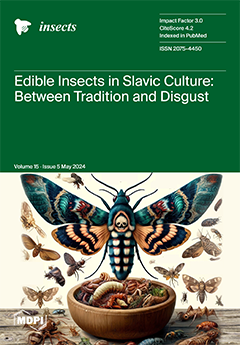The purpose of this experiment was to evaluate the effects of different levels of BSF on rumen in vitro fermentation gas production, methane (CH
4) production, ammonia nitrogen (NH
3-N), and volatile fatty acids (VFAs). The experiment comprised four treatments, each
[...] Read more.
The purpose of this experiment was to evaluate the effects of different levels of BSF on rumen in vitro fermentation gas production, methane (CH
4) production, ammonia nitrogen (NH
3-N), and volatile fatty acids (VFAs). The experiment comprised four treatments, each with five replicates. The control group contained no BSF (BSF0), and the treatment groups contained 5% (BSF5), 10% (BSF10), and 15% (BSF15) BSF, respectively. Results showed that at 3 h, 9 h, and 24 h, gas production in BSF5 and BSF10 was significantly higher than in BSF0 and BSF15 (
p < 0.05). Gas production in BSF5 and BSF10 was higher than in BSF0, while gas production in BSF15 was lower than in BSF0. At 6 h and 12 h, CH
4 emission in BSF15 was significantly lower than in the other three groups (
p < 0.05). There were no differences in the pH of in vitro fermentation after BSF addition (
p > 0.05). At 3 h, NH
3-N levels in BSF10 and BSF15 were significantly higher than in BSF0 and BSF5 (
p < 0.05). At 6 h, NH
3-N levels in BSF5 and BSF10 were significantly higher than in BSF0 and BSF15 (
p < 0.05). Acetic acid, propionic acid, butyric acid, and total VFAs in BSF0, BSF5, and BSF10 were significantly higher than in BSF15 (
p < 0.05). In conclusion, gas production, CH
4 emission, NH
3-N, acetic acid, propionic acid, butyric acid, and VFAs were highest in BSF5 and BSF10 and lowest in BSF15.
Full article






